
Welcome to the Multiversity Year in Review for 2021! To call this a weird year is a Hulk-sized understatement, but one thing that was a pleasant surprise was the sheer number of interesting and excellent comics that came out this year. We’ve got over 25 categories to get through, so make sure you’re checking out all of the articles by using our 2021 Year in Review tag.
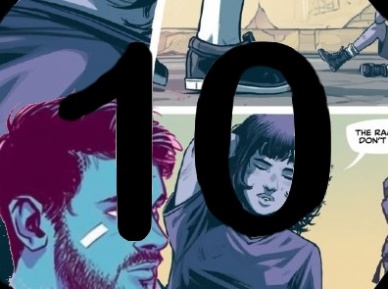
10. Caspar Wjingaard
Caspar Wjingaard was often a bit of a background artist for me. I always enjoyed their work on the periphery with covers and series like “Angelic” but it never tickled my fancy beyond a decent appreciation for their craft. Until I saw their work on “Home Sick Pilots”.
Wjingaard’s work on this book encapsulates that vibrant, hazy, grunge energy of the nineties and channels it through so many mediums so well. The blues and purples that are so frequent in his body of work are really pushed in this comic, becoming much more associated with MTV glowing on your mum’s television set late at night. Wjingaard also delivers great period-appropriate fashion for the characters without ever feeling too cheesy, giving us checkered flannel shirts where appropriate and elevating further with little details like wallet chains every so often.
But for my money, it’s what you don’t expect from this comic that Wjingaard delivers so well. It’s the seamless incorporation of an organic/metallic exoskeleton, a demon made from VHS tape, and even a damned haunted-house-turned-city-sized-mecha that shows Wjingaard has such an effortless mastery of every theme this comic tries its hand at. 2021 made me a Caspar Wjingaard fan and I’m so glad about it. – Rowan Grover
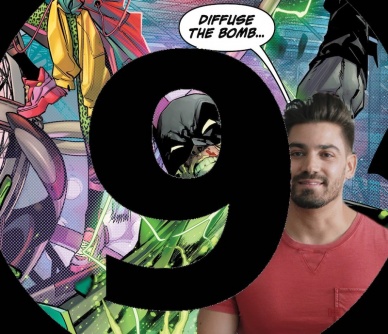
9. Jorge Jiménez
Jorge Jiménez has one of the most distinctive styles in comics. It’s grounded in traditional comic book art style with clear, crisp linework and mostly straightforward paneling. But then there’s the cinematic element that he brings to the table- the way that each frame he draws feels like it’s communicating something specific and vital. The way that his layouts masterfully control the pace of an issue, bringing a sense of unstoppable motion to some scenes and slowing you down to breathe in others. And then there’s the way that his character work feels almost reminiscent of anime. Jiménez imbues his characters with a sense of energy that isn’t matched by anyone else in the business. Their expressions are clear and their movements kinetic. All together, these qualities bring a sense of life to Jiménez’s work that’s almost impossible to find anywhere else.
In 2021, Jiménez worked exclusively in the Gotham City, mostly as the main artist on James Tynion IV’s “Batman” but with one side story in “Future State: Gotham” #6. In the process, Jiménez has made his mark as one of the great “Batman” artists. He captures villains like Scarecrow with proper reverence to the sense of terror that they work so hard to imbue in their victims. His Bat-family action is incredible. He does excellent work balancing the grace and acrobatics that they utilize with the somewhat brutal nature of their styles. A flip is beautiful and a punch looks like it has the power of a sledgehammer (and in the case of Harley Quinn the sledgehammer feels like a wrecking ball). Most importantly, though, Jiménez can make you feel hope for a place like Gotham. So much of his work has revolved around “Fear State” which sends Gotham to rock bottom (again). At the end, when the dust settles, light starts to appear again in the city and the Bat-family looks into the sky. In that moment, Jiménez is able to make you feel their sense of accomplishment, relief, and hope for a better day. It’s simple but not easy and Jiménez sells it with gusto.
Continued belowWith just one series, Jiménez has made his mark on 2021 and on one of the most popular characters in comics. It’s exciting to imagine where he can go from here. – Quinn Tassin
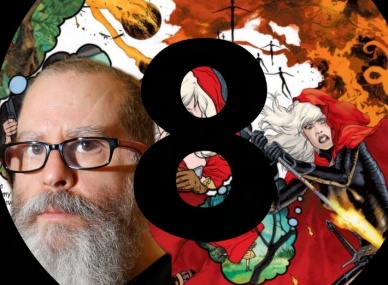
8. JH Williams III
Comic writers often say they love working in comics because their stories’ visuals aren’t hindered by VFX technology or budget. They let their imaginations run wild and leave it to the artist to make it happen. We as fans know not every artist can deliver on that. But when you look at who some of the most imaginative writers in comics (Alan Moore, Neil Gaiman,…) continually use as their visual partner, you’ll see the same name come up: J. H. Williams III.
JH Williams III is the best artist in mainstream comics. Yes, art is not a competition and yes, other artists can successfully communicate the needs of their story just as effectively as Williams and yes, there are other artists absolutely doing fantastic work (see the rest of this page). But no one in comics today accomplishes as much on as many levels as clearly as Williams. While mere mortal artists work hard to maintain A consistent style, Williams seems to be able to dail his up & down, stronger or fainter, at will.
Comics live & die by an artist’s storytelling chops, but in some ways their draftsmanship skills can be more important. Beautiful comics with incoherent storytelling still fly off the shelves, but Echolands shows Williams continuing to render his fantasy mashup setting with a staggering level of detail, ebbing and flowing as needed for emotional or expositional beats. His pages have the depth and detail to suck readers in and lose themselves in his line, but he constructs them in ways that always lead those readers back to the narrative at hand. Be it character movement to random geometric shapes acting as panel borders to in-world architecture breaking up story beats in ways Will Eisner would feel proud to have inspired, I’ve never been lost reading a JHWIII comic, and I won’t be starting with Echolands.
Williams continued to bring the impossible to comic shops in 2021, so he deserves to be on this list. – Greg Matiasevich

7. (tie) Rod Reis
If 2020 was the year I fell in love with the artwork of Rod Reis, 2021 is the year he become the gold standard. The range this guy has! His style is somehow scratchy and abstract, but also very clean and easy to follow. Colors don’t always stay in the lines, but body language is easy to read. Reis has been a regular player in the world of “X-Men” comics and his versions of certain characters have taken hold of my imagination. When I think about Wolfsbane or Shadow King? I think of the Reis versions. His is exactly the kind of art I love in superhero comics. His influences are some of the greats- you can see the Bill Sienkiewicz stylings plainly, and there’s even a bit of Chris Samnee in there- but the final product is all his own, artistically compelling but most importantly, fantastic storytelling. I hope Reis draws “X-Men” for 30 more years. I hope he gets to draw every character at Marvel and DC. I hope he draws a wild creator-owned book. I guess what I am really hoping for is all the time in the world for Mr. Reis to keep doing his thing! – Jake Hill

7. (tie) Elena Casagrande
Just like Fraction and Aja’s “Hawkeye” or Ewing and Bennet’s “Immortal Hulk”, Kelly Thompson and Elena Casagrande are going career work, redefining “Black Widow” for a new generation, proof of that is their recently earned Eisner Award for best series.
This is why Elena Casagrande earned a spot on our list, her art here is extraordinary, with dynamic movements and gorgeous action scenes, often featuring a ton of moments on double spreads. Her characteristic style with the use of a “camera”, unfocusing things, and heavy inks, make one of the most beautifully drawn books from Marvel.
Last year we had an intimate, personal story about Natasha’s family, but this year we had two new threats, Apogee and an unnamed villain, and the book shifted into some kind of a “team book”, featuring Yelena, Anya Corazón, new characters Craig and Lucy and brief appearances of both Hawkeyes and Bucky. And Casagrande’s art adapted easily into this shift.
Continued belowIssue #12 deserves a special shout-out, the team goes to a gala and the designs Casagrande did for each character are gorgeous, from the androgynous host resembling Tilda Swinton to Natasha’s black widow-like dress, and flowers, tons of flowers. Next year we can only hope the story keeps growing, and with it, Casagrande’s art. – Ramon Piña
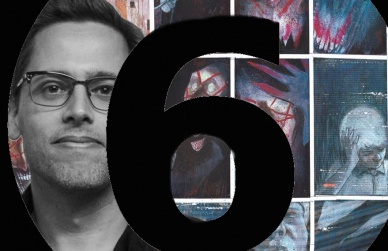
6. Martin Simmonds
Martin Simmonds is an incredibly technically talented artist, his knack for formalist cartooning carries all the expressionist scratchiness of 80s Sienkiewicz and Cowan alongside a modern eye towards more cinematic panel framing, every image he does is effortlessly engaging, and it has been that way for years. But then he started on “Department of Truth,” and it’s becoming clear that he is one of the most creative symbolist artists in modern comic art, and his appetite for new stylistic exploration is a rabid force that has kept his readers engaged all year.
Simmonds is constantly bearing the brunt of a heavy amount of exposition in “Department of Truth,” it’s just par for the course in a story with that much detail to portray, the weird part is that the exposition never grinds. His art is just so visually lush and heavy with fidelity that it simply keeps your attention from ever straying away. This was never more evident than in “Department of Truth” #9, arguably the best issue for the series all year, which zeroes in on the history of magic and symbols throughout history. The reason that story works so well, despite its layers of history and esoterica, is because Simmonds has that same knack for symbolism, he knows the weight and skeuomorphic potential of every image he creates, twists and reinterprets.
Alongside artists like Rod Reis and Mike Huddleston, Martin Simmonds is leading the charge of the cartooning frontier into a world of stylistic flexibility and visual hyperbole. His layers of shorthand, visual dynamism and formalist creativity is built into the central organs of what comics should be. Martin Simmonds is reinterpreting the style of storytelling, and I would be surprised if his fingerprint and influence won’t be blaringly visible on the comics of the future. – James Dowling
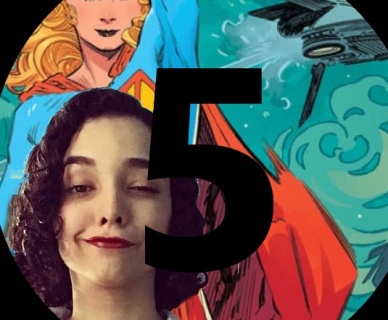
5. Bilquis Evely
I’m lucky to be able to write about Bilquis Evely for both Artist and Cover Artist for 2021. Evely’s bio in this year’s “Batman: Black and White” #3 describes her as “one of the most elegant stylists in comics”. I don’t think I could have put it better myself. This is her second year in a row on this list and one look at her work shows she deserves it.
For the aforementioned “Batman: Black and White” she wrote and illustrated “A Kingdom of Thorns”. A detailed high fantasy that allowed Evely lean into what I think she does best: gorgeous fantastical worlds. This was a unique opportunity to look at her art without interpretation by a colorist. While her work is often elevated even further by the colors of Matheus Lopes, I love seeing the original line work. I’m always finding surprising new details in each panel. Whenever she posts art on social media it’s an opportunity to see the details of a master of the craft.
Her major work this year is her collaboration with writer Tom King and colorist Matheus Lopes on “Supergirl: Woman of Tomorrow”. The five issues so far have given us dream like locations, imaginative creatures, and a Kara with wings of fire; harkening back to the Earthborn Angel Linda Danvers. All done in Evely’s inimitable style. While the book showcases her strengths for high fantasy it also shows something else Evely is great at: character acting. Her faces can tell the story with no dialogue and I’m always pulled in by the way she draws eyes.
Her bio in Batman concludes by saying “her pages politely demand multiple examinations”. I highly suggest you meet those demands. – Matthew Vincenty
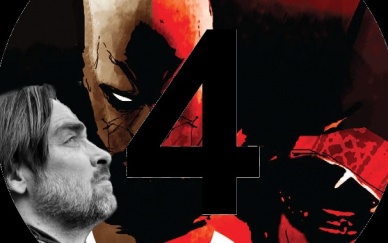
4. Andrea Sorrentino
Andrea Sorrentino continues to be one of the best comic artists out there and making Multiversity’s list of top ten artists for the fourth year in a row. While “Gideon Falls” ended last year, he gets another chance to work with Jeff Lemire with a science and historical fiction story called “Prodigal.”
Continued belowSorrentino gets to showcase the skills he developed from the “Gideon Falls” horror genre and bring it to science fiction, and show that they aren’t that different after all. His use of panels piled on top of one another and splitting imagery creates these trippy-looking moments. Sorrentino can also help the reader focus more on the story itself rather than the details in the character design. They’re often covered in some shadow that helps create an uncertain environment or reality for the reader.
Sorrentino is also ending the year with the mini-series “Batman: The Imposter,” a book that lets him dig into the dark and grittiness of Gotham. Not that Gotham needs much help with that part, Sorrentino gets the opportunity to create a noir-like vibe with his heavy tones and darker tones. From the huge splash pages and attention to detail in the background, it may be his chance to get more involved with Batman come 2022. – Alex Manzo

3. Dan Mora
Dan Mora is one of those “how do they do it?” artists. Consistent stints on “Detective Comics” and “Future State: Dark Detective” (DC) with Mariko Tamaki and Jordie Bellaire AND “Once and Future” (Boom!) with Kieron Gillen and Tamra Bonvillain treated us to plenty of the Costa Rican artist’s stylish, solid, stellar sequential work all through 2021. Mora also contributed covers to “Mighty Morphin” (Boom!) and elsewhere, showing off his ability to make art that pops.
Mora definitely knows how to make a gorgeous comics page. Like the best of them, Capullo, Staples, Windsor-Smith, Mignola, Mora’s interiors can play like a dance of beautiful figures when the scene calls for it, dappled with background Gotham in autumn brownstones, characters lost in carefree joie-du-vivre. Or pages can explode with monstrosities, sinewed undead or viral worms spring-loaded with creepy kinetic potential. Or, when it serves the story, an eye-catching, panel-breaking Batman, or an equally imposing and cool-looking Grandma Bridgette McGuire, popping out of sewers or caves, anchoring a page of intrigue. Mora is that artist whose pages make you thrill, and then you’re unsurprised to find his name in the credits.
But what vaults the 2016 Russ Manning Award winner this high on the list for us is how Mora can turn that luscious art so consistently and effectively into immersive storytelling. Part of that, of course, is volume and consistency, and a reader’s conscience is always pricked by the hope that such a productive artist is being duly rewarded with rest and remuneration. Because there’s something about reading page after solid page of Dan Mora comics that has me utterly lost in the story, only to occasionally surface and wonder, “how in the world am I treated to so much of so finely-drawn a visual world?” – Paul Lai
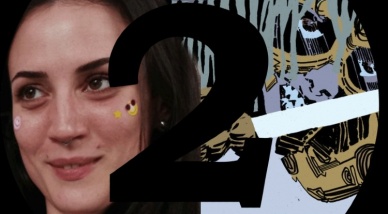
2. Dani
Last year, we listed Dani as one of the Breakout Writers of 2020 and, one year later, she came just a few votes shy of being our staff’s favorite artist of the year. It’s quite the jump for a young creator, but Dani’s 2021 was so strong that no one on staff even raised an eyebrow over the status shift. Dani is just that good.
This year, Dani spent a lot of time at DC, specifically in the Bat books, where she was able to embrace both the darkness and the weirdness of her work. The crown jewel of her year is “Arkham City: The Order of the World,” which feels, visually, like it could’ve come out of the golden age of Vertigo, but has a modern edge to it that is unlike anything that really came before. Dani brings the terror to this book, both by the lingering sense of dread that hangs over it and the ghastly horror she draws on the page. Dani seems like the type of creator who will only be at DC for so long before going the creator-owned route, so let’s hope that DC has knows what it has in its hands and gives Dani whatever she wants to draw from now on. – Brian Salvatore

1. Daniel Warren Johnson
Some comics allow a creator to showcase all of their strengths and create something truly memorable. One of the people who has been consistently successful at this is Daniel Warren Johnson. Johnson gets you excited to read a series, mainly because he has a remarkable blend of compelling creative action and emotional storytelling. So it’s no surprise that he’s at the top of our 2021 list because he just keeps delivering exceptional work.
Continued belowThis year, Johnson’s major work was “Beta Ray Bill,” which gave him a chance to explore the depth and vulnerability of the great Korbonite warrior. Like his exceptional “Murder Falcon,” “Beta Ray Bill” is a story that, while epic, is mainly about healing and self-acceptance. People praise Johnson for his ability to imbue emotions in the panels of his pages, and “Beta Ray Bill” is no exception. Even in Bill’s static cybernetic form, Johnson conveys surprise, pain, anger, and joy. Add to that his ease at creating compelling backgrounds and action sequences, and every page come to life.
Johnson’s style has a loose feel to it, but it helps to convey size and scope in so many ways. His backgrounds often feel vast and close to endless, sometimes awe-inspiring but often brutal. In many ways, Johnson’s art feels akin to the kind of artwork you see on the cover of metal albums, which is a feature, not a bug. Johnson is incredibly open about what inspires his art, ranging from album covers to professional wrestling. He’s an artist who revels in maximalism, creating epic fight sequences or having his character kick through their sound effects. It’s dynamic and almost appears to move on the page. It pulls you in and keeps you moving forward, but his solid emotional storytelling keeps you anchored.
“Beta Ray Bill” isn’t the only work that Daniel Warren Johnson gave us this year. He also had stories in “Batman: Black & White” and “Superman: Red & Blue.” While the Batman story is good, the Superman story is spectacular. In eight pages and a limited color palette, Johnson shows exactly who Superman is and how he ticks. There is little action. It’s all raw, vulnerable emotions of a father’s love and a son’s legacy. “Beta Ray Bill” shows Johnson’s love of epic, bombastic adventures, “Superman: Red & Blue,” his love of making the world better than you left it. In both cases, they’re a reminder of why Daniel Warren Johnson is at the top of this list. -Joe Skonce






